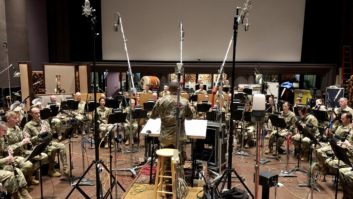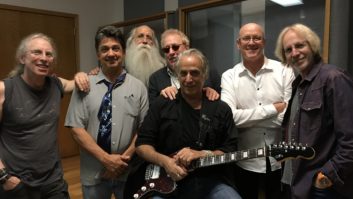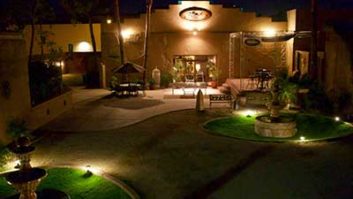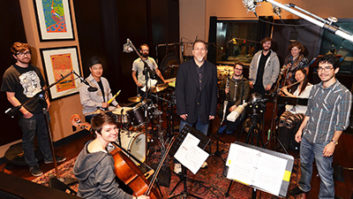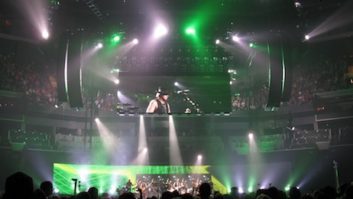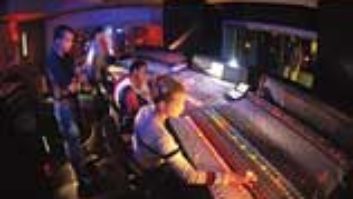Bon Jovi rocks a million faces with a Lab.gruppen-powered
Clair i-5/i-5B system with i-3, BT-218 and FF-II components.
by Strother Bullins.

On April 22 in Charlotte, North Carolina, my sister and I saw Bon Jovi in the midst of the ongoing The Circle Tour—thus far the top grossing tour of 2010. As it was for many others in attendance, this sold-out event was indeed a circle—and, for us, a large one. A quarter century after we convinced my mom and dad to take us to see a band called Ratt with opener Bon Jovi (at the time, a young and hungry act on Mercury Records), my sis and I were once again in the charismatic, crowd-winning presence of Jon and his band.
Though bookended by stunning, modern visuals—LED screens featuring attractive, storytelling graphics and video alongside excitement-evoking light displays—I found the sounds of The Circle Tour to be comparably simple, clear and classic. It’s only rock ’n’ roll, if you will. And for me, it’s what made this event so compelling; in our increasingly analog-less world of universal-reaching pop entertainment, witnessing what’s behind the music on a new Bon Jovi tour was inspiring in a very organic way.
“You don’t mix Beyoncé the same way you mix Bon Jovi,” understates front-of-house engineer David Eisenhauer, currently celebrating his 10th year and fifth tour mixing Bon Jovi live. Gesturing at the audio systems on hand, he says, “I and [monitor engineers] Glenn Collett and Andy Hill have found what works for the guys. These are things that they are happy with, and we don’t try to reinvent the wheel.”
Serviced by Clair worldwide, this tour’s rig consists of a Midas XL4 at FOH, while dual Midas Heritage 3000 desks serve as monitor consoles. House speakers consist of a Clair i-5/i-5B system with i-3, BT-218 and FF-II components, while sparingly placed monitor speakers consist of Clair 12AM, 212AM, SRM, L3 NT/LF and ML-18 components; the band, except for guitarist/vocalist Richie Sambora, use Shure PSM 600/PSM 700 and Sennheiser G2 personal monitoring systems. All FOH amplification is provided via Lab.gruppen. Alongside some racks of analog processing and outboard multi-effects units, an Avid Pro Tools HD rig most often captures each night’s performance via all mic preamps’ direct outputs.
David Eisenhauer mans
a Midas XL-4 at the
Bon Jovi FOH position.
During a brief, pre-show tour of “the underworld”—Bon Jovi’s backstage monitor mix setup—Eisenhauer explains the scene. “Jon doesn’t like to see anyone working [while playing], so everything is custom-built into the stage, giving everyone concealed workspace. Glenn operates one console, mixing for Jon the entire night as well as the other band members on IEMs.

“Meanwhile, Andy mixes Richie on the other console. Richie doesn’t like closed-off ears; being a guitar player, he’s so used to hearing his guitar in a big, open environment that he only uses high-end enhancers in-ear. He still has speakers in front of him—two 12AMs built into the grates underneath—and a small PA behind him for drums and keys. Richie’s zone here is big, full and hi-fi, but it also doesn’t disturb anybody else on the stage; it’s actually nice and clean. Elsewhere, Tico [Torres, drummer], other than having a Clair ML-18, is also in-ears.”
Monitor mix demands are clear, explains Collett. “Jon wants it to sound like a record. So, I’m constantly mixing and adapting to whatever different levels people play, keep all the vocals in balance so the blend sounds like a chord, bring up solos and audience, when required. It’s obviously live, and full of compromises, but it’s about supplying everything, not just part of it.”
Predominantly Shure microphones, the transducers on stage were chosen by Eisenhauer and Collett based on some simple, “no compromise” requirements. “We could’ve used Gucci microphones on everything, but because we have to play in so many different environments on this tour, we went with a simple mic package that we know is bulletproof and sounds exactly the same whether we’re in an arena or a stadium. So, everything you see is very straightforward: Shure SM91s and SM52s on the kit, SM57s, and lots of SM98s. ’Cause there’s one thing about these guys: They don’t have a lot of patience when things go wrong. We choose gear that always works.”
Back at front of house, Eisenhauer continues this gear selection philosophy for all his crucial signal paths, and he explains his various choices in analog outboard that sit to the right of his XL4. “I’ve had the same basic vocal chain forever,” he said. “The Amek Rupert Neve 9098 EQ going into the Summit TLA-100, that gives me more control than I’ll ever need for Jon’s vocal. I’m also a big fan of the Alan Smart bus compressor, which is like a rackmounted SSL G Series bus compressor. I put it over the whole mix, so I can track and rope in the whole thing. It gives the house mix an overall ‘album-like’ quality; it’s what we’re going for.
“Then there are my Aphex 612 expander/gates,” he continues. “I use them lightly just to keep the cymbals out of the drums. Especially on the newer material, Tico plays a lot of grace notes with a general finesse on the toms. At the beginning of the tour, I spent a lot of time with [drum technician] Joe Dorosz; we’d hone in on the predominant frequency that the drum was producing and were eventually able to dial in the gates where Tico could hit the drum with a brush and it would open it. We set it up for a really long release time so you don’t hear it breathing, and it works.”
Eisenhauer regularly references original studio recordings to best match reverbs to certain songs. This most often has him leaning on his preferred effects units, four TC Electronic M5000 processors. “Just from listening back to the early records, I know a lot of it was the Lexicon 480L,” he says. “So I found that the 480 Hall in the TC Electronic M5000 sounds really similar, which bypasses the quirkiness of actually taking a 480L on the road. I actually have my M5000s set up for two engines each, but three out of the four of them are set to 480 Hall, just on various times.
He explains, “Early on, one of the things that Jon and I agreed upon was that we liked when everything sounded like it was ‘coming from the same place.’ I found that using the same type of reverb on everything, but at various times—my instrument reverb a bit shorter than my vocal reverb, for instance—kept everything sounding like you were standing across the room listening instead of the drum kit sounding like it’s in a different room.”
On stage, Sambora’s “zone” is all about inspiration and the guitar effects he wants to hear at the moment of creation. But out front, the guitar sound is Eisenhauer’s, thanks to a non-effected guitar head specifically for house sound.
“Richie and I were chatting, and we realized that a lot of the effects he wants to hear on stage really don’t translate that well to the PA or our recording system. So we decided to designate my own guitar head to work from, a Marshall paired with a 4×12 iso box. It’s great because it’s just straight guitar: no effects, just a big, fat sound. I do all of Richie’s house effects in the PA, and it works great. Then he gets to put on any combination of effects he wants for inspiration. He digs it because he knows what I’m doing is in true stereo as opposed to being one-dimensional, and I’m not stuck with something that sounds like good effects for his own mix yet doesn’t translate in the PA.”
For the rest of July, Sambora will remain “in the zone” as the band and crew barnstorm through stadium shows across the U.S. After that they’ll be taking a few months off before reconvening at the end of the year for an Asia/South Pacific run. Only then will The Circle—and its tour—be complete.
Strother Bullins is the reviews and features editor for Pro Audio Review.
For Dave Eisenhauer’s thoughts on Bon Jovi’s three-night stand opening New Meadowlands Stadium, visitPro Sound News’ blog.
Clair
www.clairglobal.com
Shure
www.shure.com
Bon Jovi
www.bonjovi.com
